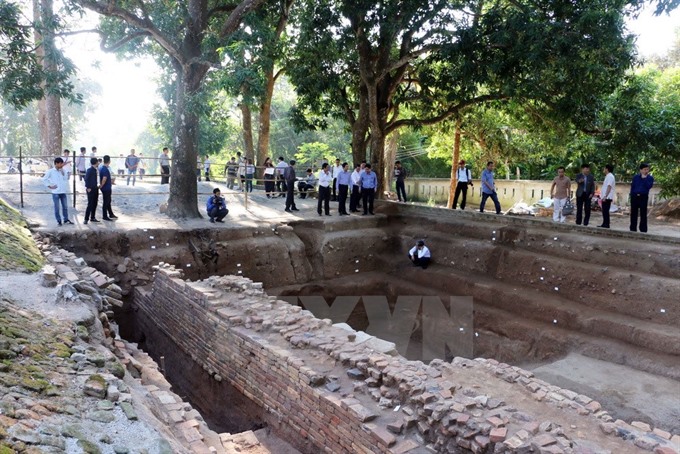Scientists have gathered 20,000 objects dated back to the first century BC at an excavation in the southern province of An Giang. The results were announced at a workshop held on January 3.

Ancient kingdom: Visitors at the excavation site at Linh Sơn Pagoda. — VNA/VNS Photo Công Mạo
Scientists focused on objects found at Linh Sơn Pagoda, a relic from the Óc Eo civilisation. It is sited at Trung Sơn Village in Óc Eo Town in Thoại Sơn District in An Giang Province.
Researcher Phạm Văn Triệu from the Việt Nam Social Sciences Academy, said since August, after a long time excavating the site, scientists erected 15 columns to mark the site. They have dug two pits, each covering 300sq.m, where they have defined five continuous historical periods ranging from the second to the 12th century AD.
In the pits, researchers found about 20,000 tiles, bricks and other architectural objects, ceramic ware (saucepans, bowls, dishes) and broken pieces of statues.
According to academy researcher Lê Đình Phụng, the Óc Eo civilisation formed about 2,000 years ago in the south-western area of the country.
“The findings help us have a fresh look at a once flourishing civilisation – the Phù Nam [Funan, ancient Khmer] Civilisation in Southeat Asia,” he said, “From that, we may preserve and further research the culture’s values in a uniformed and scientific way.”
Researcher Nguyễn Quang Thuấn, chairman of the academy, said the excavation results at the pagoda confirmed that Óc Eo was associated with Phù Nam Kingdom, a great trading nation with contacts throughout South-east Asia and as far as India.
From the excavations, scientists can confirm that Óc Eo-Ba Thê used to be a large centre of economic-culture for Óc Eo-Phù Nam culture.
Nền Chùa at that time was an important port, where goods were imported and exported for Óc Eo urban area and towns throughout Long Xuyên Quadrangle Area in particular and Southwestern region in general.
Óc Eo, in Thoại Sơn District, An Giang Province, was first discovered by Luis Malleret of the French School of Far East in 1944. After 1975, scientists continued to further excavate neighbouring the areas and found various other valuable sites. The sites that have been dug later in the area are also considered belong to Óc Eo Culture because Óc Eo was the first place unearthed and possessed the most typical relic sites of Phù Nam (Funan) Kingdom (68AD - 550AD). — VNS